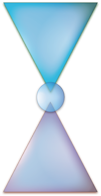
Clotho - http://www.clothocad.org
Clotho is a software platform for designing and assemblying synthetic biological systems. Clotho provides a mechanism to connect repositories of biological parts with a wide variety of apps designed to use that information. Apps include sequence viewers, scripting environments, and assembly algorithms. Clotho provides a data model which is consistent with the needs of the synthetic biology community and provides access to it via an easy to use API.
Clotho is an open source project with collaborations at Boston University, UC Berkeley, MIT, BBN Technologies, and the BioFAB. For more complete information, please visit the website.

Eugene - http://www.eugenecad.org
Eugene is a domain specific language for synthetic biological systems. Eugene allows for both the specification of synthetic biological designs based on biological parts, as well as providing a very expressive constraint system to drive the automatic creation of composite Devices from a collection of individual Parts.
Eugene allows for the rapid design space exploration of composite devices by permuting individual devices using available parts and rules for their composition. Eugene then communicates with the Clotho design environment in order to interface with liquid handing robots for an automated assembly flow for synthetic biology.
For more information, please visit the Eugene website.
Cross-disciplinary Integration of Design Automation Research
http://www.cidarlab.org
Cross-disciplinary Integration of Design Automation Research at Boston University looks at ways to integrate automation techniques into disciplines not traditionally defined by rigorous design automation methodologies. Specifically it is an interdisciplinary research area bringing expertise into areas such as synthetic biology and cyber physical systems. CIDAR has computational research carried out in the Department of Electrical and Computer Engineering and experimental research carried out in the Center for Advanced Biotechnology (CAB). CIDAR is the support mechanism for both the Clotho and Eugene projects. It is lead by Douglas Densmore. For more information, please visit the CIDAR website.

Platform-Based Design of Embedded Electronic Systems
http://
Platform-Based Design is a methodology which explicitly separates functionality (what something does) for implementation (how it does it). This orthogonalization of concerns allows for a rich design space exploration process.
In particular I am focused on the following three areas:- System Level Architecture Modeling - This work investigates techniques to create models of highly programmable systems (FPGAs, ASIPs, etc) at the system level. Specifically how to capture the services offered by the models. This should be done in a way which is abstract and modular while remaining efficient and accurate. Models of Xilinx’s Virtex II Pro, ARM7, ARM9, and Sparc architectures have explored and Sun Microsystem’s/UC Berkeley’s FLEET architecture has been examined in the past.
- Refinement Verification - Unlike equivalence checking, refinement verification traditionally looks to ensure that a refined model contains a subset of an abstract model’s behaviors (not the full set necessarily). This works examines the issues involved in doing refinement verification of architecture models at the system level.
- Programmable Platform Characterization - A modular and scalable approach for automatically extracting actual performance information from a set of FPGA-based architecture topologies. We use this information dynamically during simulation to support performance analysis in a System Level Design environment. These topologies capture systems representing common designs using FPGA technologies of interest. Their characterization is done only once; the results are then used during simulation of actual systems being explored by the designer. Our approach allows a rich set of FPGA architectures to be explored accurately at various abstraction levels to seek optimized solutions with minimal effort by the designer.
